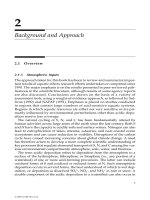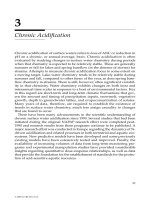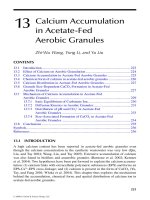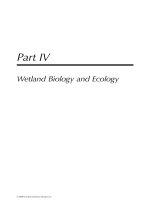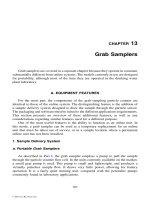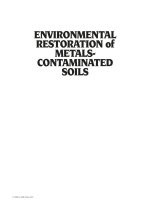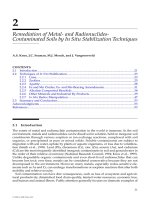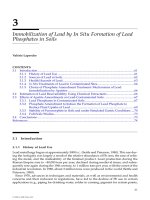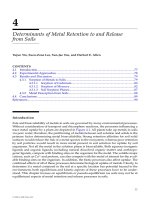ENVIRONMENTAL RESTORATION of METALSCONTAMINATED SOILS - CHAPTER 13 potx
Bạn đang xem bản rút gọn của tài liệu. Xem và tải ngay bản đầy đủ của tài liệu tại đây (247.68 KB, 11 trang )
261
13
Effects of Natural Zeolite and Bentonite on the
Phytoavailability of Heavy Metals in Chicory
László Simon
CONTENTS
13.1 Introduction 261
13.2 Materials and Methods 262
13.2.1 Soil Sample Collection and Characterization 262
13.2.2 Characterization of Natural Zeolites and Bentonite Used in the Experiment 262
13.2.3 Growth Chamber Pot Experiments with Chicory 263
13.2.4 Elemental Analysis of Soil and Plant Samples 264
13.2.5 Statistics 264
13.3 Results and Discussion 264
13.3.1 Phytoavailability of Heavy Metals in a Galvanic Mud-Contaminated Soil 264
13.3.2 Immobilization of Heavy Metals with Natural Zeolites and Bentonite 265
13.4 Conclusions 270
Acknowledgments 270
References 270
13.1 Introduction
Clay minerals have high cation sorption and cation exchange capacity and large surface
area (Adriano, 1986; Alloway, 1990; Kabata-Pendias and Pendias, 1992). Natural and syn-
thetic zeolites (sodium aluminum calcium silicates) have high affinity to sorb and to com-
plex trace elements, particularly heavy metals (Mineyev et al., 1990; Baidina, 1991; Gworek,
1992, 1994; Obukhov and Plekhanova, 1995; Chlopecka and Adriano, 1996; Shanableh and
Kharabsheh, 1996) and caesium (Campbell and Davies, 1997). Similar properties of bento-
nite (montmorillonite, sodium aluminum magnesium hydrosilicate) were observed by
Krebs and Gupta (1994). Besides other soil additives (e.g., lime, phosphate, apatite, iron
oxide, manganese oxide, organic matter) natural zeolites and bentonites have the potenti-
ality of immobilizing heavy metals in contaminated soils and of preventing their accumu-
lation in agricultural plants (Mench et al., 1998).
During recent decades the environmental consequences of industrialization were
neglected in Hungary. In many cases the environmental pollution was not revealed, e.g., the
contamination of kitchen garden soil with heavy metals in the neighborhood of a former
galvanization plant in the city of Nyíregyháza (Northeastern Hungary) was discovered only
4131/frame/C13 Page 261 Friday, July 21, 2000 4:48 PM
© 2001 by CRC Press LLC
262
Environmental Restoration of Metals–Contaminated Soils
in 1991. The transition to a market economy is pressing a clean-up of the most critical con-
taminated sites of the country. The Hungarian government therefore initiated a new envi-
ronmental remediation program in 1996. Hungary is rich in natural zeolites and bentonites,
therefore these relatively cheap clay minerals may play an important role in the soil remedi-
ation program.
Considering the above facts the objectives of our study were to evaluate (1) concentration
of heavy metals in a soil contaminated with galvanic mud, (2) phytoavailability, transport,
and distribution of heavy metals in chicory plant grown in this contaminated soil, (3) heavy
metal immobilization capacity of three different natural zeolites and a bentonite with the
help of chicory indicator plant.
13.2 Materials and Methods
13.2.1 Soil Sample Collection and Characterization
The uncontaminated (control) soil used in this experiment originated from the demonstra-
tion garden of College of Agriculture, Nyíregyháza. The soil samples contaminated with
heavy metals were collected in a kitchen garden located near a former galvanization plant
(Nyíregyháza, Vasgyár Street). Several basic characteristics of the soils (pH
KCl
, clay + silt
[<0.02 mm particles] content, organic matter %, cation exchange capacity [CEC], macro-
element concentrations) were determined according to Hungarian standards. Basic charac-
teristics of the uncontaminated soil used in the experiment were the following: pH
KCl
: 6.6;
clay + silt content: 15.8%; organic matter: 1.3%; CEC: 18.1 meq/100 g, P 0.9 g/kg, K 4.3 g/kg,
Ca 34.3 g/kg, and Mg 7.6 g/kg. The soil contaminated with heavy metals had the following
basic properties: pH
KCl
: 6.8; clay + silt content: 16.0%; organic matter: 1.1%; CEC: 8.2 meq/100 g,
P 1.4 g/kg, K 2.4 g/kg, Ca 53.3 g/kg, and Mg 4.8 g/kg (all elements were determined in
HNO
3
/H
2
O
2
extracts). Both soils were slightly acidic loamy sands and had brown forest
soil character.
The plots were sampled with stainless steel gauge auger. Two parallel soil samples were
taken from 0 to 25 cm depth combining 20 subsamples. After air drying the soil samples
were screened on a 2-mm sieve. To determine exchangeable or “plant available” fraction of
heavy metals 5 g of soil samples were extracted with 50 cm
3
of 0.01
M
CaCl
2
or Lakanen-
Erviö solution (0.02
M
H
4
EDTA in ammonium acetate buffer, pH 4.65), respectively. To
extract “total” amount of heavy metals 2-g samples were digested with cc. HNO
3
and H
2
O
2
(3:1 v/v) prior to elemental analysis. Samples were shaken for 2 h.
13.2.2 Characterization of Natural Zeolites and Bentonite Used in the Experiment
Three different types of natural zeolites (RBZ clinoptilolitic rhyolite tuff, MHZ mordenite rhy-
olite tuff, and MSC clay mixed clinoptilolite [clinoptilolite altogether with H-montmorillonite]
and a bentonite (MHB montmorillonite) sample originated from Healing Minerals
Geoproduct Ltd. (Mád, Hungary) and were mined in Zemplén Hills, Hungary.
The RBZ type is a medium-hard microporous zeolite. Composition: clinoptilolite
≈
50%,
mordenite 0-10%, altered volcanic glass 20-30%, montmorillonite 10-15%, quartz 0-5%,
feldspar 0-5%, and limonite 1-2%. Characteristics: density
≈
2.05 g/cm
3
, wet surface pH: 7.8,
NH
4
+
-ion exchange capacity: 118 meq/100 g, Ag
+
-ion binding capacity: 177 meq/100 g. The
4131/frame/C13 Page 262 Friday, July 21, 2000 4:48 PM
© 2001 by CRC Press LLC
Effects of Natural Zeolite and Bentonite on the Phytoavailability of Heavy Metals in Chicory
263
MHZ type is a hard porous light zeolite. Composition: mordenite 40-60%, altered volcanic
glass 20-30%, montmorillonite 10-15%, quartz 0-5%, feldspar 0-5%, and limonite 1-2%.
Characteristics: density
≈
1.82 g/cm
3
, wet surface pH: 7, NH
4
+
-ion exchange capacity:
70 meq/100 g, Ag
+
-ion binding capacity: 176 meq/100 g. The MSC type is a rare and
worldwide unique soft zeolite formation. The main components are clinoptilolite and
H-montmorillonite which are present at the same ratio. Characteristics: density
≈
1.50 g/cm
3
,
wet surface pH: 5-6, NH
4
+
-ion exchange capacity: 65 meq/100 g, Ag
+
-ion binding capacity:
52 meq/100g. The MHB type bentonite is a gray, wet, soft, and plastic clay. It contains,
besides calcium potassium montmorillonite, illite, crystoballite, kaolinite, and amorphous
volcanic glass. Physicochemical properties: swelling in water, absorption and ion-
exchange of Na
+
-cations, tixotrophy, formation of stabile suspension-gel (characterization
and analytical data are courtesy of Tibor Mátyás from Healing Minerals Geoproduct Ltd.,
Mád, Hungary).
13.2.3 Growth Chamber Pot Experiments with Chicory
Growth chamber pot experiments were conducted with chicory (
Cichorium intybus
L., var.
foliosum
Hegi, cv. Wild) to study the phytoavailability of heavy metals in the galvanic mud
contaminated soil (Experiment 1), and their immobilization with zeolites and a bentonite
(Experiment 2). Larger amounts of uncontaminated and contaminated soil were collected
during 1995 and 1996 as described above; the soils were air dried, homogenized, and
screened on a 2-mm sieve before utilization.
Experiment 1
: Chicory was grown in uncontaminated basic soil mixed (or replaced) with
0, 10, 25, 50, 75, or 100% (m/m) of heavy metal contaminated soil (collected in 1995) in a
growth chamber experiment. A completely randomized experimental design with six
replications was used. In one plastic pot (16 cm diameter) with 1500 g of soil three
uniformly sized 4-week-old seedlings were planted. After 8 weeks of growth (temperature:
25 ± 2°C, illumination: 5000 lux for 8 h daily, watering: regularly with distilled water to
maintain constant field capacity moisture content) the plants were harvested and separated
into underground parts (roots and rhizomes) and shoots. Plant samples were washed in tap
water and rinsed in three-times-changed deionized water. After the determination of dry
weights (70°C, 14 h) the samples were ground (<1 mm) and digested with cc. HNO
3
and
H
2
O
2
(3:1 v/v) prior to elemental analysis. The experiment was done between February
and April 1995.
Experiment 2
: Chicory was grown in uncontaminated soil or in heavy metal-contaminated
soil (collected in 1996). The heavy metal-contaminated soil was amended with 5% (m/m)
of three different types of zeolite (RBZ clinoptilolite; MHZ mordenite; MSC clinoptilolite
altogether with H-montmorillonite) or MHB montmorillonite (bentonite), respectively. The
zeolite and bentonite samples were dried (105°C, 3 h), ground, and sieved. The <0.25-mm
fraction was thoroughly mixed with heavy metal-contaminated soil and moisturized with
distilled water. After 14 days of soil incubation three plants (6-week-old seedlings with
three to five true leaves) were planted in one pot containing 1500 g of soil–zeolite/bentonite
mixture. All other growth conditions were as described in Experiment 1; the plants were
processed after 8 weeks of growth. After harvesting of plants the soil-zeolite/bentonite
growth medium was sampled in three replicates from every pot. The samples were sieved
(<0.5 mm) to remove root debris, air dried, and extracted with CaCl
2
, EDTA in ammonium
acetate buffer, or cc. HNO
3
and H
2
O
2
(3:1 v/v) to determine the exchangeable, “plant available,”
and “total” concentration of heavy metals in growth medium at the end of the experiment.
The experiment was done between February and June 1996.
4131/frame/C13 Page 263 Friday, July 21, 2000 4:48 PM
© 2001 by CRC Press LLC
264
Environmental Restoration of Metals–Contaminated Soils
13.2.4 Elemental Analysis of Soil and Plant Samples
The elemental composition of soil and plant samples was determined by the inductively
coupled argon plasma emission spectrometry (ICAP, model Labtam 8440M, Australia)
technique in triplicate at the Central Chemical Laboratory, Debrecen University of Agricul-
tural Sciences, Debrecen, Hungary. For validation of plant analysis CRM 281 rye grass
(Commission of the European Communities, Community Bureau of Reference, Brussels)
certified reference material was used.
13.2.5 Statistics
Statistical analysis of the experimental data was done by Student’s t-test using Statistix 4.0
software (Statistix, 1992).
13.3 Results and Discussion
13.3.1 Phytoavailability of Heavy Metals in a Galvanic Mud-Contaminated Soil
Careless handling of galvanic mud resulted in contamination of the kitchen garden soil
with cadmium (Cd), chromium (Cr), copper (Cu), nickel (Ni), and zinc (Zn) (Table 13.1).
The heavy metal concentrations in the uncontaminated control soil were in common range.
The Cd, Cr, and Ni concentrations in the contaminated soil exceeded the Hungarian and
international regulatory values (Kádár, 1995; Adriano, 1986; Alloway, 1990; Kabata-Pendias
and Pendias, 1992). The regulatory limits for heavy metal concentrations in arable soils are
1 to 3 mg/kg for Cd, 75 to 100 mg/kg for Cr, 75 to 100 mg/kg for Cu, 50 mg/kg for Ni, and
200 to 300 mg/kg for Zn in Hungary, depending on soil properties (Kádár, 1995).
Chicory has been demonstrated as an indicator plant for Cd contamination in soils or
nutrient solution (Simon et al., 1996), and chicory indicated the excess of Cd, Mn, and Zn
in municipal sewage sludge compost used as a soil amendment (Simon et al., 1997). This
sensitive indicator plant was grown in the contaminated soil to study the phytoavailability,
accumulation, and distribution of the above heavy metals. With increasing ratio of the con-
taminated soil vs. uncontaminated soil, linearly increasing amounts of Cd, Cr, Cu, and Zn
were detected in chicory roots and rhizomes and shoots (Figures 13.1 and 13.2).
Comparing the cadmium, chromium, copper, and zinc concentrations in roots and rhi-
zomes with shoots a close correlation was found in their accumulation (Figures 13.1 and
13.2). It means that roots and rhizomes of this species do not act as a “barrier” against the
accumulation of these trace metals in shoots. This phenomenon could useful when chicory
(cultivated or wild form) is used as a phytoindicator of heavy metal contamination in soils.
TABLE 13.1
Heavy Metal Concentrations in Uncontaminated (Control) and Contaminated Soil (determined in
cc. HNO
3
–H
2
O
2
extracts, Nyíregyháza, Hungary, 1995)
Element
(
µ
g/g) Cd Cr Cu Ni Zn
Uncontaminated soil 0.3 12.2 15.0 14.9 41.0
Contaminated soil 10.1* 228.5* 119.0* 56.2* 107.0*
Note:
Student’s t-test. Data are means of three replications. Statistically significant at *
P
<0.001 level.
4131/frame/C13 Page 264 Friday, July 21, 2000 4:48 PM
© 2001 by CRC Press LLC
Effects of Natural Zeolite and Bentonite on the Phytoavailability of Heavy Metals in Chicory
265
The accumulation of nickel was negligible and its concentrations in chicory roots and rhizomes
or shoots did not reflect the level of soil contamination (Figure 13.3). Although 5 to 10 mg/kg
Cd, 1 to 2 mg/kg Cr or 15 to 20 mg/kg Cu in shoots may cause phytotoxicity in sensitive plant
species (Kabata-Pendias and Pendias, 1992), no phytotoxicity symptoms were observed in
chicory and the dry matter accumulation of plants was undisturbed (data not shown).
13.3.2 Immobilization of Heavy Metals with Natural Zeolites and Bentonite
Heavy metal concentrations in different extracts of the uncontaminated and contaminated
soils are shown in Table 13.2. Elevated levels of heavy metals were detected in the
FIGURE 13.1
Cadmium and chromium accumulation in roots and rhizomes and in shoots of chicory grown in a galvanic
mud-contaminated soil (pot experiment, Nyíregyháza, Hungary, 1995).
25
20
15
10
5
0
0 20 40 60 80 100
Heavy metal contaminated soil (%)
Heavy metal contaminated soil (%)
ROOT and RHIZOME
Linear regression
Y=0.07+0.16x
R=0.99 SD=0.87 P<0.001
ROOT and RHIZOME
Linear regression
Y=0.45+0.016x
R=0.98 SD=0.12 P<0.01
SHOOT
Linear regression
Y=0.25+0.06x
R=0.99 SD=0.25 P<0.001
SHOOT
Linear regression
Y=4.2+0.09x
R=0.81 SD=2.9 P<0.05
Cadmium (µg/g)
10
8
6
4
2
0
0 20 40 60 80 100
Cadmium (µg/g)
Heavy metal contaminated soil (%)
20
18
16
14
12
10
8
6
4
2
0
0 20 40 60 80 100
Heavy metal contaminated soil (%)
3.0
2.5
2.0
1.5
1.0
0.5
0.0
0 20 40 60 80 100
Chromium (µg/g)
Chromium (µg/g)
4131/frame/C13 Page 265 Friday, July 21, 2000 4:48 PM
© 2001 by CRC Press LLC
266
Environmental Restoration of Metals–Contaminated Soils
exchangeable and “plant available” fractions of the contaminated soil; this predicts the
danger of entering these heavy metals into the biosphere (Table 13. 2). The heavy metal concen-
trations were higher in samples collected in 1995 than in 1996 (compare Tables 13.1 and 13.2);
this indicates the heterogeneity of soil contamination in the kitchen garden.
Dry matter accumulation of chicory was unaffected by heavy metal contamination of the
soil or by zeolite or bentonite treatment of this soil (Table 13.3). No visible phytotoxicity
symptoms were observed. The water absorption or macronutrient (P, K, Ca, Mg) uptake of
plants was undisturbed by zeolite or bentonite application (data not shown).
FIGURE 13.2
Copper and zinc accumulation in roots and rhizomes and in shoots of chicory grown in a galvanic mud-
contaminated soil (pot experiment, Nyíregyháza, Hungary, 1995).
24
22
20
18
16
14
12
10
8
6
4
2
0
0 20 40 60 80 100
Heavy metal contaminated soil (%)
Copper (µg/g)
50
45
40
35
30
25
20
15
10
5
0
0 20 40 60 80 100
Heavy metal contaminated soil (%)
Copper (µg/g)
ROOT and RHIZOME
Linear regression:
y=10.2+0.07x
R=0.98 SD=0.69 P<0.001
80
70
60
50
40
30
20
10
0
0 20 40 60 80 100
Heavy metal contaminated soil (%)
Zinc (µg/g)
ROOT and RHIZOME
Linear regression:
y=31+0.312x
R=0.98 SD=2.93 P<0.001
SHOOT
Lineat regression:
y=15.9+0.22x
R=0.9 SD=4.7 P<0.05
X
X
80
70
60
50
40
30
20
10
0
0 20 40 60 80 100
Heavy metal contaminated soil (%)
Zinc (µg/g)
SHOOT
Linear regression:
y=32.3+0.2x
R=0.80 SD=6.33 P<0.05
X
X
X
X
X
X
X
X
X
X
4131/frame/C13 Page 266 Friday, July 21, 2000 4:48 PM
© 2001 by CRC Press LLC
Effects of Natural Zeolite and Bentonite on the Phytoavailability of Heavy Metals in Chicory
267
The zeolite and bentonite additives reduced the accumulation of zinc in chicory roots
(Table 13.4). A slight reduction in Ni, Cr, and Cu accumulation was also observed in several
cases but the rate of this has not proved to be statistically significant (Table 13.4). Consider-
ing the heavy metal concentrations in the whole plants (roots and rhizomes + shoots) a sim-
ilar tendency was observed; in the zeolite- or bentonite-treated cultures 16 to 25% less Cr,
Cu, and Zn was measured than in controls. Observations of other authors based on similar
pot experiments are controversial, indicating in most cases zinc immobilization by zeolites
in contaminated soils. Baidina (1991) found that zeolite application decreased Zn and Pb
FIGURE 13.3
Nickel accumulation in roots and rhizomes and in shoots of chicory grown in a galvanic mud-contaminated
soil (pot experiment, Nyíregyháza, Hungary, 1995).
TABLE 13.2
Heavy Metal Concentrations in Different Extracts of an Uncontaminated (Control) and Contaminated
Soil in Nyíregyháza, Hungary, 1996
Cd Cr Cu Ni Zn
µg/g
Extractant CaCl
2
Uncontaminated soil <0.01 <0.01 0.07 <0.01 <0.01
Contaminated soil 0.10* <0.01 0.20* 0.14* <0.01
Extractant H
4
EDTA in ammonium acetate buffer (Lakanen-Erviö)
Uncontaminated soil 0.6 0.9 8.6 0.9 14.7
Contaminated soil 48.9* 36.7* 93.7* 25.0* 77.7*
Extractant cc. HNO
3
– H
2
O
2
Uncontaminated soil 0.9 28.3 17.4 19.9 55.7
Contaminated soil 53.5* 327.3* 125.0* 95.3* 139.7*
Note:
Student’s t-test. Data are means of 3 replications. Statistically significant at * P <0.05 level.
3.0
2.5
2.0
1.5
1.0
0.5
0.0
0 20 40 60 80 100
Heavy metal-contaminated soil (%)
Nickel (µg/g)
ROOT and RHIZOME
Linear regression:
y=1.5+0.002x
R=0.35 SD=0.23 P<0.48
4.5
4.0
3.5
3.0
2.5
2.0
1.5
1.0
0.5
0.0
0 20 40 60 80 100
Heavy metal-contaminated soil (%)
Nickel (µg/g)
SHOOT
Linear regression:
y=1.16+0.005x
R=0.55 SD=0.33 P<0.26
4131/frame/C13 Page 267 Friday, July 21, 2000 4:48 PM
© 2001 by CRC Press LLC
268
Environmental Restoration of Metals–Contaminated Soils
mobility in a zinc-smelter contaminated soil, but heavy metal accumulation of beet was not
diminished. Mineyev et al. (1990) found that natural zeolite decreased the concentration of
mobile zinc in Zn, Cd, and Pb contaminated soil, but the negative effects of heavy metals
were not reduced in barley. In another pot study natural zeolite (clinoptilolite) significantly
reduced the Zn concentration in maize and barley grown in soil artificially contaminated
with Zn (Chlopecka and Adriano, 1996). Obukhov and Plekhanova (1995) got similar
results; application of zeolite reduced the mobility of Pb and Zn in a contaminated soil, and
their uptake in maize and barley. Synthetic zeolite introduction to a contaminated soil
reduced the Zn content of lettuce leaves by 36 to 65% (Gworek, 1994). In a sewage sludge
or heavy metal salts-contaminated soil, however, zeolite application had no effect on heavy
TABLE 13.3
Dry Matter Accumulation in Chicory Grown in Heavy-Metal Contaminated Soil Treated with Zeolite
and Bentonite (pot experiment, Nyíregyháza, Hungary, 1996)
Treatment
Root and rhizome Shoot
(g/plant)
Uncontaminated soil (1) 0.12 0.42
Contaminated soil (2) 0.13
ns
0.39
ns
2 + 5% RBZ clinoptilolite 0.10
ns
0.39
ns
2 + 5% MHZ mordenite 0.17
ns
0.39
ns
2 + 5% MSC clinoptilolite with H-montmorillonite 0.10
ns
0.38
ns
2 + 5% MHB montmorillonite (bentonite) 0.16
ns
0.38
ns
Note:
Student’s t-test. Data are means of six replications.
ns: Statistically not significant as compared to treatment 1.
TABLE 13.4
Heavy Metal Accumulation in Chicory Grown in Galvanic Mud-Contaminated Soil Treated with
Zeolites and Bentonite (pot experiment, Nyíregyháza, Hungary, 1996)
Treatment
Cd Cr Cu Ni Zn
(
µ
g/g)
Root and Rhizome
1 1.4 6.1 17.3 4.2 43.8
2 27.6 109.7 59.5 11.0 43.9
3 25.3 79.5 48.5 8.6 27.1
x
3 23.1 90.9 53.7 9.0 30.2
5 21.1 66.5 38.6 17.4 32.7
x
6 22.3 92.3 50.0 8.2 28.9*
Shoot
1 2.0 1.8 9.3 2.2 29.9
2 40.8 5.2 13.2 4.0 34.9
3 39.7 4.6 13.4 3.8 36.2
4 43.1 3.0 13.3 3.5 36.5
5 41.0 3.6 14.2 4.3 34.9
6 41.4 2.9 11.7 2.5 34.4
Note:
1: control uncontaminated soil
2: contaminated soil
3: 2 and 5% clinoptilolite
4: 2 and 5% mordenite
5: 2 and 5% clinoptilolite with H-montmorillonite
6: 2 and 5% montmorillonite (bentonite)
Student’s t-test. Data are means of three replications. Statistically significant at
x
P
<0.1.
*
P
<0.05 level as compared to treatment 2.
4131/frame/C13 Page 268 Friday, July 21, 2000 4:48 PM
© 2001 by CRC Press LLC
Effects of Natural Zeolite and Bentonite on the Phytoavailability of Heavy Metals in Chicory
269
metal concentrations in chicory (Scotti et al., 1995). Sodium montmorillonite mixed with
zinc contaminated soil reduced zinc-concentration in plants without causing physiological
deficiency of this element (Krebs and Gupta, 1994).
In Table 13.5. heavy metal concentrations are shown in different extracts of zeolite or
bentonite-treated contaminated soil after 8 weeks of chicory growth. Zeolite or bentonite
amendments significantly reduced the exchangeable (CaCl
2
extractable) Zn content in the
contaminated soil. “Plant available” (Lakanen-Erviö solution extractable) or “total”
(cc. HNO
3
– H
2
O
2
extractable) concentrations of zinc, however, remained unaffected by
zeolite or bentonite application. Since the exchangeable form of Zn in soil is considered as
the most bioavailable to plants (Kabata-Pendias and Pendias, 1992), the definitively lower
exchangeable Zn in zeolite or bentonite-treated soils may explain the lower Zn uptake in
chicory roots. Our results confirm the findings of Chlopecka and Adriano (1996); zeolite
(clinoptilolite) ameliorant significantly reduced the exchangeable form of Zn in a flue
dust-contaminated soil, and Zn uptake in maize or barley test plants.
TABLE 13.5
Heavy Metal Concentrations in Different Extracts of Uncontaminated (Control) Soil and of
Zeolite/Bentonite Treated Contaminated Soil after 8 Weeks of Chicory Growth (pot experiment,
Nyíregyháza, Hungary, 1996)
Treatments
Cd Cr Cu Ni Zn
(
µ
g/g)
Extractant CaCl
2
1 <0.01 <0.03 0.05 <0.02 <0.01
2 <0.01 <0.03 0.1 <0.02 0.05
3 <0.01 <0.03 0.23* <0.02 <0.01*
4 <0.01 <0.03 0.24* <0.02 <0.01*
5 <0.01 <0.03 0.08 <0.02 <0.01*
6 <0.01 <0.03 0.03* <0.02 <0.01*
Extractant H
4
EDTA in ammonium acetate buffer (Lakanen-Erviö)
1 0.3 0.1 9.7 2.3 9.8
2 35.7 11.0 68 15.2 41.2
3 33.0 11.8* 68 16.6* 41.9
4 32.9 11.8* 68 16.0* 41.9
5 32.6 12.0* 74* 16.2* 43.2
6 32.4 11.5* 68 15.2 40.9
Extractant cc. HNO
3
– H
2
O
2
1 1.1 21.9 17.6 16.9 47.3
2 35.5 218 103 90 112
3 33.4 218 103 91 116
4 36.8 241* 113* 98 119
5 35.0 223 126* 91 116
6 37.0 230 105 87 108
Note:
1: control uncontaminated soil
2: contaminated soil
3: 2 and 5% clinoptilolite
4: 2 and 5% mordenite
5: 2 and 5% clinoptilolite with H-montmorillonite
6: 2 and 5% montmorillonite (bentonite)
Student’s t-test. Data are means of three replications.
Statistically significant at *
P
<0.05 level as compared to treatment 2.
4131/frame/C13 Page 269 Friday, July 21, 2000 4:48 PM
© 2001 by CRC Press LLC
270
Environmental Restoration of Metals–Contaminated Soils
13.4 Conclusions
The soil of a kitchen garden located near a former galvanization plant was found to be con-
taminated with Cd, Cr, Ni, Cu, and Zn. Chicory indicator plant grown in this soil accumu-
lated elevated levels of Cd, Zn, Cu, and Cr in its roots and rhizomes and in shoots. Dry
matter accumulation of chicory was unaffected by heavy metal contamination of soil or by
zeolite or bentonite application. Natural zeolites and bentonite reduced the accumulation
of Zn in chicory roots and rhizomes, and a slight decrease was also detected in Ni, Cr, and
Cu uptake of the test plants. The decrease in Zn uptake of chicory may be related to
decrease in exchangeable (bioavailable) form of zinc in contaminated soil after zeolite or
bentonite application. We plan open-field experiments with crop plants to study and verify
the long-term heavy metal immobilization effects of Hungarian natural zeolites and bento-
nites in contaminated soils.
Acknowledgments
This research was supported by the Hungarian Scientific Research Fund (project F016906),
the Foundation for the Hungarian Higher Education and Research (project 681/96), and
Hungarian Soros Foundation. Valuable help was provided by Prof. Dr. Zoltán Györi
(Central Chemical Laboratory, Debrecen University of Agricultural Sciences, Debrecen,
Hungary) and his co-workers, Drs. József Prokisch and Béla Kovács, in elemental analysis.
The help of Tibor Mátyás (Healing Minerals Geoproduct Ltd., Mád, Hungary) in zeolite
and bentonite characterization is gratefully acknowledged.
References
Adriano, D.C.,
Trace Elements in the Terrestrial Environment
, Springer-Verlag, New York, 1986, 1–95.
Alloway, B.J., Ed.,
Heavy Metals in Soils
, Blackie & Son, Ltd., Glasgow and London, 1990, 29–39.
Baidina, N.L., The use of zeolites as heavy metal absorbents in technogenically contaminated soils
(in Russian),
Izvestiya Sibirskogo Otdeleniya Akademii Nauk SSSR.
, Seriya Biologicheskikh Nauk, 6,
32, 1991.
Campbell, L.S. and B.E. Davies, Experimental investigation of plant uptake of caesium from soils
amended with clinoptilolite and calcium carbonate, Plant and Soil, 189(1), 65, 1997.
Chlopecka, A. and D.C. Adriano, Mimicked in situ stabilization of metals in a cropped soil: bioavail-
ability and chemical form of zinc, Environmental Science and Technology, 30(11), 3294, 1996.
Gworek, B., Lead inactivation by zeolites, Plant and Soil, 143, 71, 1992.
Gworek, B., Zeolites of the 3A and 5A type as factors inactivating zinc in soils contaminated with
this metal, Roczniki Gleboznawcze, 44 (Suppl.), 95, 1994.
Kabata-Pendias, A. and H. Pendias, Trace Elements in Soils and Plants, CRC Press, Boca Raton, FL,
1992, 3–66.
Kádár, I., Contamination of the Soil-Plant-Animal-Man Food Chain with Chemical Elements in Hungary
(in Hungarian), KTM, MTA-TAKI, Budapest, 1995, 86–371.
Krebs, R. and S.K. Gupta, Mild remediation techniques for heavy metal contaminated soils
(in German), Agrarforschung, 1(8), 349, 1994.
4131/frame/C13 Page 270 Friday, July 21, 2000 4:48 PM
© 2001 by CRC Press LLC
Effects of Natural Zeolite and Bentonite on the Phytoavailability of Heavy Metals in Chicory 271
Mench, M., J. Vangronsveld, N.W. Lepp, and R. Edwards, Physico-chemical aspects and efficiency
of trace element immobilization by soil amendments, in Metal-Contaminated Soils: In Situ
Inactivation and Phytorestoration, Vangronsveld, J. and S. D. Cunningham, Eds., Springer-Verlag,
Berlin, and R.G. Landes Company, Georgetown, TX, 1998, 151–182.
Mineyev, V.G., A.V. Kochetavkin, and B. Nguyen-Van, Use of natural zeolites to prevent heavy-metal
pollution of soils and plants, Soviet Soil Science, 22 (2), 72, 1990.
Obukhov, A.I. and I.O. Plekhanova, Detoxication of dernopodzolic soils contaminated by heavy
metals: theoretical and practical aspects (in Russian), Agrokhimiya, 2, 108, 1995.
Scotti, I. A., E. Lombi, and G.M. Beone, Influence of natural materials on assimilation ability of heavy
metals (in Italian), Annali della Facolta di Agraria, Universita Cattolica del Sacro Cuore Milano, 35(1-2),
69, 1995.
Simon, L., J. Prokisch, and B. Kovács, Chicory (Cichorium intybus L.) as bioindicator of heavy metal
contamination, in Contaminated Soils: 3rd Int. Conf. on the Biogeochemistry of Trace Elements, Paris,
May 15-19 1995, Prost, R., Ed., CD-ROM, D:\data\communic\066.PDF, Colloque n°85, INRA
Editions, Paris, France, 1997.
Simon, L., H.W. Martin, and D.C. Adriano, Chicory (Cichorium intybus L.) and dandelion (Taraxacum
officinale Web.) as phytoindicators of cadmium contamination, Water, Soil and Air Pollution, 91,
351, 1996.
Shanableh, A. and A. Kharabsheh, Stabilization of Cd, Ni, and Pb in soil using natural zeolite,
Journal of Hazardous Material, 45, 207, 1996.
Statistix 4.0, User’s Manual, Analytical Software, St. Paul, MN, 1992.
4131/frame/C13 Page 271 Friday, July 21, 2000 4:48 PM
© 2001 by CRC Press LLC
